Global Wind Power Generator Market Forecast
- Global market for wind power generators worth US$20.7 Bn in 2022 to reach approximately US$31 Bn by 2030
- Wind power generator market size likely to expand at a CAGR of 5.3% between 2023 and 2030
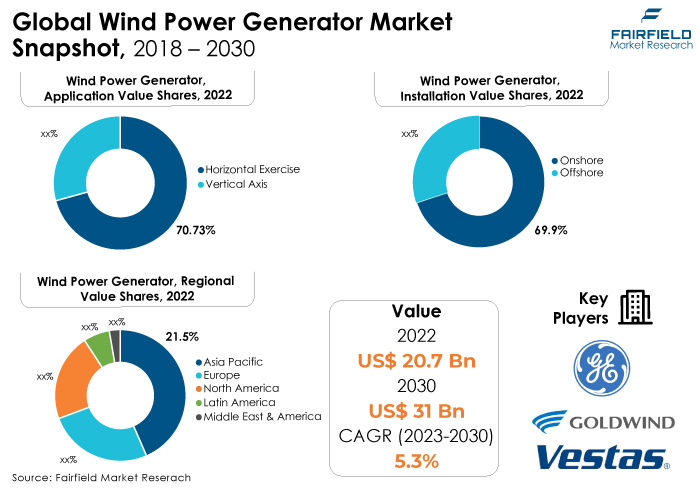
Quick Report Digest
- The outlook for the global wind power generator market remains positive, with continued growth anticipated as technology improves, costs decline, and more countries commit to transitioning to sustainable and renewable energy sources.
- As wind power capacity grows, challenges related to grid integration and intermittency persist, leading to increased focus on energy storage solutions and smart grid technologies to ensure a stable and reliable power supply.
- There has been a surge in investments in the wind energy sector, with governments and private entities allocating substantial funds to support the development and installation of wind power generators.
- Ongoing advancements in wind turbine technology, including taller towers, larger rotor diameters, and improved efficiency have contributed to the overall growth of the market.
- Supportive government policies and incentives like tax credits, feed-in tariffs, and renewable energy targets have played a crucial role in fostering the growth of the wind power generator market globally.
- Growing environmental concerns, and a heightened focus on reducing carbon emissions have driven the adoption of renewable energy sources, with wind power emerging as a key contributor to clean energy goals.
- The decreasing cost of wind energy production, coupled with improved cost competitiveness compared to traditional energy sources, has further accelerated the adoption of wind power generators on a global scale.
- The offshore wind sector has witnessed substantial growth, with an increasing number of countries investing in and deploying offshore wind farms, tapping into the vast potential of wind resources in marine environments.
- The major factors driving the market include the surging demand for clean and sustainable energy to address growing concern on climate change and greenhouse gas emissions.
- Key players like Siemens, GE, Vestas, Goldwind, and Mitsubishi are focusing on capacity expansion to maintain their market shares, and to sustain.
- China, the US, India, and Germany hold a significant share in global wind power generator market.
- Growing concerns around the environmental impact of fossil fuels and the critical urgency to combat climate change have led to increased demand for clean and renewable energy sources like wind power, which will foster demand in wind power generator market.
- Expansion of digitalisation, and the Internet of Things (IoT) is playing a transformative role in the wind power generator market, resulting in more efficient, reliable, and cost-effective wind energy solutions.
- Data analytics is used for energy forecasting, energy storage integration, real-time control, and performance monitoring.
A Look Back and a Look Forward - Comparative Analysis
The wind power generator market has undergone a remarkable transformation in the comparative analysis between 2018-2022 and the projected period of 2023-2030. In the earlier period, 2018-2022, the market experienced robust growth marked by a surge in installed capacity worldwide. This phase was characterised by increased investments, technological advancements, and supportive government policies, driving the competitiveness of wind energy. Technological improvements in turbine efficiency and design, coupled with decreasing production costs, played a pivotal role in enhancing the market's appeal.
Looking ahead to 2023-2030, the wind power generator market is expected to witness even more substantial expansion. The global shift towards sustainable energy sources and escalating environmental concerns are anticipated to drive unprecedented growth. The increasing focus on offshore wind farms, with their potential for higher energy yields, is likely to be a key driver. Additionally, advancements in energy storage solutions to mitigate the intermittency issues, and innovations in grid integration technologies will contribute to the market's maturity.
As the market evolves, competition is expected to intensify, prompting key players to continue strategic collaborations and pursue mergers and acquisitions. The overarching trend suggests a positive trajectory for the wind power generator market, as it cements its position as a leading contributor to the global renewable energy landscape in the coming decade.
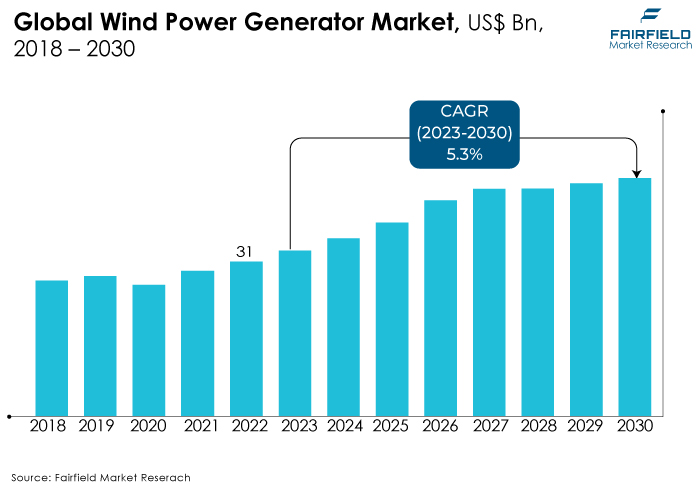
Major Growth Determinants
Advancements in Technology, and Supportive Government Policies
Ongoing innovations in wind turbine technology, such as taller towers, larger rotor diameters, and sophisticated control systems, enhance efficiency, driving the growth of the wind power generator market by increasing energy output and reducing costs.
Robust governmental support in the form of incentives, tax credits, and renewable energy targets encourages investment in wind power projects, fostering market growth. Policy frameworks worldwide are crucial in creating a conducive environment for the development and expansion of wind energy installations.
Environmental Sustainability Drive
Heightened global awareness of climate change and environmental sustainability propels the demand for clean energy sources like wind power. As countries strive to reduce carbon footprints, the wind power generator market experiences substantial growth driven by the increasing adoption of renewable energy solutions to meet sustainability goals.
Key Growth Barriers
Intermittency Challenges and Grid Integration
The inherent intermittency of wind resources poses a challenge to grid stability. As wind power's share in energy production increases, the grid must cope with variable output. Developing effective grid integration solutions and energy storage systems is critical to mitigating these challenges and ensuring a reliable power supply.
Land Use, and Environmental Concerns
The expansion of onshore wind farms faces constraints due to land use conflicts and environmental concerns. In densely populated areas, competition for land can hinder the deployment of onshore wind projects. Addressing these concerns requires careful planning, environmental impact assessments, and community engagement to strike a balance between renewable energy development and preserving ecosystems and local landscapes.
Key Trends and Opportunities to Look at
Growing Prominence of Offshore Wind Farms
The wind power generator market is witnessing several key trends that are shaping its trajectory. There is a notable shift towards larger, more efficient turbines, driven by technological advancements, enabling increased energy production. Offshore wind farms are gaining prominence, capitalising on stronger and more consistent wind resources. In addition, the industry is witnessing a rise in hybrid projects, combining wind with energy storage or other renewable sources for enhanced reliability.
Digitalisation, and smart technologies are becoming integral, optimising operations and maintenance processes. A growing focus on circular economy principles is driving efforts towards recycling and repurposing end-of-life turbine components, addressing sustainability concerns.
The expansion of offshore wind projects presents a major opportunity in the global wind power generator market. Offshore wind has enormous potential due to stronger and more consistent wind resources compared to onshore locations. Advancements in technology, such as floating wind turbines and deeper water installations, are unlocking new areas for offshore wind development. Countries around the world are increasingly investing in large-scale offshore wind farms, presenting significant growth opportunities for wind power generator manufacturers.
Increasing Integration of Energy Storage Solutions
The integration of energy storage solutions with wind power generators represents another key opportunity. The intermittent nature of wind energy production can be addressed by combining wind power with advanced energy storage technologies such as batteries. This integration enhances grid stability, allows for better management of energy fluctuations, and ensures a more reliable and consistent power supply.
As the demand for clean and reliable energy grows, the deployment of wind power coupled with energy storage solutions offers a compelling opportunity for industry players to meet the evolving needs of the global energy landscape.
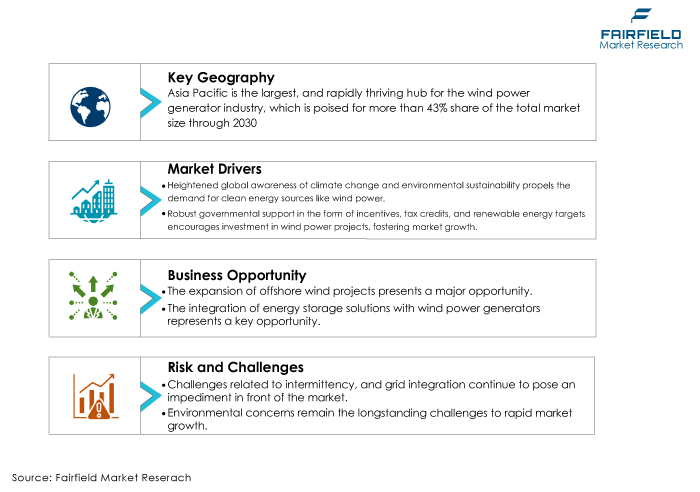
How is the Regulatory Scenario Shaping this Industry?
The wind power generator market presents abundant growth opportunities, primarily driven by the global push towards renewable energy. Offshore wind expansion, especially in emerging markets, offers immense potential. Technological innovations, such as next-gen materials and advanced control systems, open avenues for increased efficiency and cost reduction. Collaborations between industry stakeholders and governments can unlock regulatory and financial support, fostering market growth.
With the rising demand for sustainable energy, developing markets in Asia, and Africa present untapped opportunities for wind power projects. Moreover, advancements in energy storage technologies create possibilities for addressing the intermittency-related challenges, further enhancing the attractiveness of wind power in the broader energy landscape. The regulatory scenario plays a pivotal role in shaping the wind power generator industry. Supportive policies and regulations have been instrumental in fostering market growth.
Governments worldwide have implemented incentives such as tax credits, feed-in tariffs, and renewable energy targets to encourage investment in wind energy projects. These regulatory frameworks create a favourable environment for stakeholders, attract financing, and drive technological innovation. Additionally, stringent environmental regulations and carbon reduction commitments drive the adoption of wind power as a clean energy source, aligning with global efforts to combat climate change.
Grid codes and standards also influence the industry, shaping how wind power integrates with existing energy infrastructure. However, regulatory uncertainties and changing policies can pose challenges. Long-term policy stability is crucial for attracting sustained investments and ensuring the industry's growth trajectory. A proactive regulatory approach that addresses grid integration, permitting processes, and community engagement will be essential to harness the full potential of wind power and facilitate its seamless integration into the broader energy landscape.
Fairfield’s Ranking Board
Onshore Installations Continue to Dominate
The onshore wind power segment remains a dominant force in the wind power generator market, contributing significantly to global renewable energy capacity. Cost-effectiveness, mature technology, and established infrastructure favour onshore wind projects. Key trends include the deployment of larger turbines for increased efficiency, improved grid integration solutions, and the revitalisation of aging wind farms through repowering initiatives. The major challenges involve land use conflicts, and community resistance, collectively necessitating strategic planning and stakeholder engagement.
Globally, the onshore wind energy segment dominates the industry, marked by substantial installations. Statistics from the Global Wind Energy Council (GWEC) highlight robust growth, with onshore installations reaching 72.5 GW worldwide in 2021. Regions like Europe, Latin America, Africa, and the Middle East experienced significant onshore wind growth, indicating sustained dominance throughout the forecast period.
On the other hand, a global surge in offshore wind farm installations is a significant market trend, catalyzed by the growing demand for clean and sustainable energy. Initiatives like the Offshore Wind Power Development Strategy in India exemplify global efforts towards offshore wind projects. Large turbines deployed in offshore farms not only harness more power but also fuel the demand for direct-drive wind turbines, positioning this segment prominently in the forecast period.
Horizontal-Axis Turbine Stands out While Vertical-Axis Counterpart Picks Pace
Horizontal-axis wind turbines, with their rotor axis parallel to the wind and the earth, stand as the dominant market force. The upwind configuration, where the rotor faces the wind, prevails due to its efficiency in escaping the wind shadow behind the tower. This segment harnesses the wind's energy through rotatable propeller-mounted blades, contributing to higher energy production.
The vertical-axis wind turbine industry is gaining momentum due to its advantages in strength, size, quiet operation, and efficiency. These turbines, known for their ability to be grouped together, offer space-saving solutions suitable for home settings and modest wind installations. The rise in demand for clean, renewable energy sources propels the growth of the vertical-axis wind turbine market, making them both cost-effective and environmentally beneficial.
Regional Frontrunners
Asia Pacific Holds a Commanding Share, Best Leverages its Abundant Resources, and Strategic Investments
Asia Pacific commands the pinnacle as the largest regional market for wind power generators, propelled by escalating energy demands, a heightened environmental consciousness, and proactive governmental initiatives. China, a linchpin player, takes center stage with monumental deployments of both onshore and offshore wind projects. The report says China’s primacy, and expansive projects will continue to propel the region’s overall wind power surge.
Simultaneously, India is making substantial strides in expanding its wind capacity. Abundant wind resources, coupled with strategic investments in wind infrastructure, fuel the region's exponential growth. The confluence of burgeoning economies, favourable governmental policies, and competitive pricing positions Asia Pacific as a vibrant and thriving hub for the wind power industry, poised for sustained and rapid expansion. The region will continue to account for more than 43% share of the total market revenue.
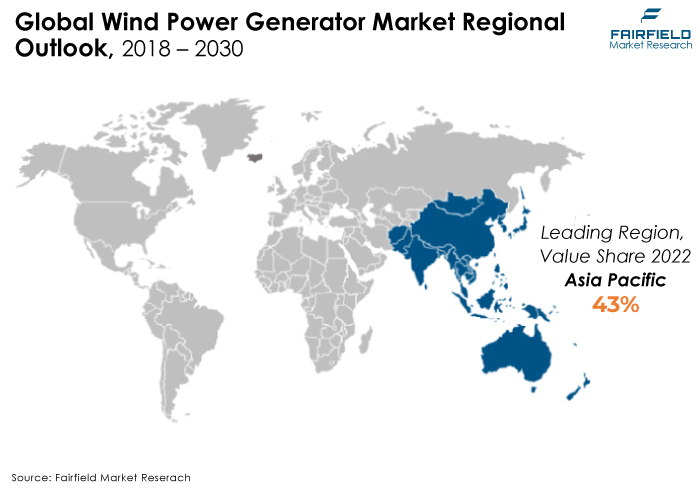
Europe Emerges Lucrative with the Most Favourable Regulatory Landscape
The European region emerges with unparalleled dynamism as the fastest-growing market for wind power generators, propelled by its avant-garde regulatory frameworks, ambitious renewable energy targets, and a well-established wind energy sector. Europe is the global innovation hub, and with a strong government backing, Europe will most likely maintain its wind energy leadership. Notably, stalwart nations such as Germany, the UK, and Denmark have spearheaded the widespread adoption of wind power.
Currently capturing over 25% share of the global market valuation, Europe's pre-eminence is further underscored by a robust offshore wind sector, ongoing grid infrastructure development, and unwavering government support. The region stands as a vanguard in technological advancements, with collaborative initiatives cementing its status as a global hub for innovation in wind energy.
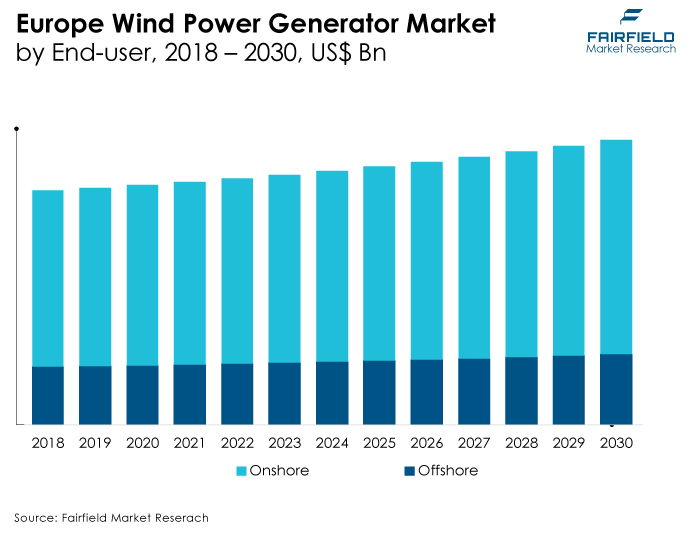
An Expert’s Eye
Demand Dynamics
The demand for wind power generators is robust and growing, primarily fueled by the global transition towards renewable energy sources. Increasing environmental awareness, stringent emission reduction targets, and the imperative to mitigate climate change are driving governments, industries, and consumers to seek cleaner energy alternatives. The demand for wind power generators is further propelled by advancements in technology, making wind energy more cost-effective and competitive. The scalability and versatility of wind power installations also contribute to sustained demand, allowing for both large-scale utility projects and smaller distributed applications.
Supply Side
The supply side of the wind power generator market is characterised by a competitive landscape with key players continually innovating to enhance turbine efficiency, reduce costs, and address environmental concerns. Major manufacturers invest heavily in research and development to introduce cutting-edge technologies, larger turbines, and sophisticated control systems.
Global collaboration and partnerships in the supply chain are common, as companies seek to leverage collective strengths and optimise manufacturing processes. The supply side is also influenced by government policies, trade regulations, and the availability of raw materials. As the market grows, supply chain resilience, scalability, and sustainability are becoming focal points, ensuring a steady and reliable provision of wind power generators to meet the rising global demand for clean energy solutions.
Fairfield’s Competitive Landscape Analysis
The global wind power generator market is consolidated, with fewer major players present across the globe. The key players are introducing new products as well as working on the distribution channels to enhance their worldwide presence. Moreover, Fairfield Market Research is expecting the market to witness more consolidation over the coming years.
Who are the Leaders in the Global Wind Power Generator Space?
- General Electric
- Vestas
- Ming Yang Smart Energy Group Limited
- Siemens
- ENERCON GmbH
- Senvion
- Goldwind
- Samsung Electronics
- United Power, Inc.
- NORDEX SE
Recent Notable Developments
- Technological Advancements
Siemens Gamesa, and GE Renewable Energy, two of the major players in the wind energy sector, have been consistently working on technological advancements. Siemens Gamesa, for instance, introduced its SG 14-222 DD offshore wind turbine, one of the largest turbines in the world. GE Renewable Energy has been focusing on enhancing the efficiency of its onshore and offshore wind turbines.
- Strategic Collaboration
Vestas, a leading wind turbine manufacturer, has engaged in strategic collaborations to strengthen its position. The company partnered with Mitsubishi Heavy Industries in a joint venture called MHI Vestas Offshore Wind, focusing on offshore wind projects. Such collaborations enable companies to combine their strengths in technology and market presence.
- Expansion of Offshore Wind Projects
Ørsted, and Equinor have been actively involved in the expansion of offshore wind projects globally. Ørsted, a major renewable energy company, has been securing contracts for large-scale offshore wind farms, while Equinor has been investing in floating wind farm technology, demonstrating a commitment to the growth of offshore wind in diverse environments.
The Global Wind Power Generator Market is Segmented as Below:
By Application
- Horizontal Axis
- Vertical Axis
By Installation
- Onshore
- Offshore
By End User
- Commercial & Industrial
- Utility & Power
- Others
By Geographic Coverage:
- North America
- U.S.
- Canada
- Europe
- Germany
- U.K.
- France
- Italy
- Turkey
- Russia
- Rest of Europe
- Asia Pacific
- China
- Japan
- South Korea
- India
- Southeast Asia
- Rest of Asia Pacific
- Latin America
- Brazil
- Mexico
- Argentina
- Rest of Latin America
- Middle East & Africa
- GCC
- South Africa
- Egypt
- Nigeria
- Rest of the Middle East & and Africa
1. Executive Summary
1.1. Global Wind Power Generator Market Snapshot
1.2. Future Projections
1.3. Key Market Trends
1.4. Analyst Recommendations
2. Market Overview
2.1. Market Definitions and Segmentations
2.2. Market Dynamics
2.2.1. Drivers
2.2.2. Restraints
2.2.3. Market Opportunities
2.2.4. Economic Trends
2.3. Value Chain Analysis
2.4. Porter’s Five Forces Analysis
2.5. COVID-19 Impact
2.5.1. Supply Chain
3. Global Wind Power Generator Market Outlook, 2019 - 2030
3.1. Global Wind Power Generator Market Outlook, by Application, Value (US$ Mn), 2019 - 2030
3.1.1. Key Highlights
3.1.1.1 Horizontal Axis
3.1.1.2 Vertical Axis
3.1.2. BPS Analysis/Market Attractiveness Analysis, by Application
3.2. Global Wind Power Generator Market Outlook, by Installation, Value (US$ Mn), 2019 - 2030
3.2.1. Key Highlights
3.2.1.1. Onshore
3.2.1.2. Offshore
3.2.2. BPS Analysis/Market Attractiveness Analysis, by Installation
3.3. Global Wind Power Generator Market Outlook, by End User, Value (US$ Mn), 2019 - 2030
3.3.1. Key Highlights
3.3.1.1 Commercial & industrial
3.3.1.2 Utility and Power
3.3.1.3 Others
3.3.2. BPS Analysis/Market Attractiveness Analysis, by End User
3.4. Global Wind Power Generator Market Outlook, by Region, Value (US$ Mn), 2019 - 2030
3.4.1. Key Highlights
3.4.1.1. North America
3.4.1.2. Europe
3.4.1.3. Asia Pacific
3.4.1.4. Middle East & Africa
3.4.1.5. Latin America
3.4.2. BPS Analysis/Market Attractiveness Analysis, by Region
4. North America Wind Power Generator Market Outlook, 2019 - 2030
4.1. North America Wind Power Generator Market Outlook, by Application, Value (US$ Mn), 2019 - 2030
4.1.1. Key Highlights
4.1.1.1 Horizontal Axis
4.1.1.2 Vertical Axis
4.2. North America Wind Power Generator Market Outlook, by Installation, Value (US$ Mn), 2019 - 2030
4.2.1. Key Highlights
4.2.1.1. Onshore
4.2.1.2. Offshore
4.3. North America Wind Power Generator Market Outlook, by End User, Value (US$ Mn), 2019 - 2030
4.3.1. Key Highlights
4.1.1.1 Commercial & industrial
4.1.1.2 Utility and Power
4.1.1.3 Others Residential
4.4. North America Wind Power Generator Market Outlook, by Country, Value (US$ Mn), 2019 - 2030
4.4.1. Key Highlights
4.4.1.1. U.S. Wind Power Generator Market, Value (US$ Mn), by Application, 2019 - 2030
4.4.1.2. Canada Wind Power Generator Market, Value (US$ Mn), by Application, , 2019 - 2030
5. Europe Wind Power Generator Market Outlook, 2019 - 2030
5.1. Europe Wind Power Generator Market Outlook, by Application, Value (US$ Mn), 2019 - 2030
5.1.1. Key Highlights
5.3.1.1 Horizontal Axis
5.3.1.2 Vertical Axis
5.2. Europe Wind Power Generator Market Outlook, by Installation, Value (US$ Mn), 2019 - 2030
5.2.1. Key Highlights
5.3.1.1 5.2.1. Onshore
5.3.1.2 Offshore
5.3. Europe Wind Power Generator Market Outlook, by End User, Value (US$ Mn), 2019 - 2030
5.3.1. Key Highlights
5.3.1.1 Commercial & industrial
5.3.1.2 Utility and Power
5.3.1.3 Others
5.4. Europe Wind Power Generator Market Outlook, by Country, Value (US$ Mn), 2019 - 2030
5.4.1. Key Highlights
5.4.1.1. Germany Wind Power Generator Market, Value (US$ Mn), by Application, 2019 - 2030
5.4.1.2. France Wind Power Generator Market, Value (US$ Mn), by Application, 2019 - 2030
5.4.1.3. U.K. Wind Power Generator Market, Value (US$ Mn), by Application, 2019 - 2030
5.4.1.4. Italy Wind Power Generator Market, Value (US$ Mn), by Application, 2019 - 2030
5.4.1.5. Spain Wind Power Generator Market, Value (US$ Mn), by Application, 2019 - 2030
5.4.1.6. Rest of Europe Wind Power Generator Market, Value (US$ Mn), by Application, 2019 - 2030
6. Asia Pacific Wind Power Generator Market Outlook, 2019 - 2030
6.1. Asia Pacific Wind Power Generator Market Outlook, by Application, Value (US$ Mn), 2019 - 2030
6.1.1. Key Highlights
6.3.1.1 Horizontal Axis
6.3.1.2 Vertical Axis
6.2. Asia Pacific Wind Power Generator Market Outlook, by Installation, Value (US$ Mn), 2019 - 2030
6.2.1. Key Highlights
6.3.1.1 Onshore
6.3.1.2 Offshore
6.3. Asia Pacific Wind Power Generator Market Outlook, by End User, Value (US$ Mn), 2019 - 2030
6.3.1. Key Highlights
6.3.1.1 Commercial & industrial
6.3.1.2 Utility and Power
6.3.1.3 Others
6.4. Asia Pacific Wind Power Generator Market Outlook, by Country, Value (US$ Mn), 2019 - 2030
6.4.1. Key Highlights
6.4.1.1. China Wind Power Generator Market, Value (US$ Mn), by Application, 2019 - 2030
6.4.1.2. India Wind Power Generator Market, Value (US$ Mn), by Application, 2019 - 2030
6.4.1.3. Japan Wind Power Generator Market, Value (US$ Mn), by Application, 2019 - 2030
6.4.1.4. South Kores Wind Power Generator Market, Value (US$ Mn), by Application, 2019 - 2030
6.4.1.4. Australia Wind Power Generator Market, Value (US$ Mn), by Application, 2019 - 2030
6.4.1.5. Rest of Asia Pacific Wind Power Generator Market, Value (US$ Mn), by Application, 2019 - 2030
7. Middle East & Africa Wind Power Generator Market Outlook, 2019 - 2030
7.1. Middle East & Africa Wind Power Generator Market Outlook, by Application, Value (US$ Mn), 2019 - 2030
7.1.1. Key Highlights
7.1.1.1 . HORIZONTAL AXIS
7.1.1.2 Vertical Axis
7.2. Middle East & Africa Wind Power Generator Market Outlook, by Installation, Value (US$ Mn), 2019 - 2030
7.2.1. Key Highlights
7.3.1.1 Onshore
7.3.1.2 Offshore
7.3. Middle East & Africa Wind Power Generator Market Outlook, by End User, Value (US$ Mn), 2019 - 2030
7.3.1. Key Highlights
7.3.1.1 Commercial & industrial
7.3.1.2 Utility and Power
7.3.1.3 Others
7.4. Middle East & Africa Wind Power Generator Market Outlook, by Country, Value (US$ Mn), 2019 - 2030
7.4.1. Key Highlights
7.4.1.1. GCC countries Wind Power Generator Market, Value (US$ Mn), by Application, 2019 - 2030
7.4.1.4. South Africa Wind Power Generator Market, Value (US$ Mn), by Application, 2019 - 2030
7.4.1.5. Rest of Middle East & Africa Wind Power Generator Market, Value (US$ Mn), by Application, 2019 - 2030
8. Latin America Wind Power Generator Market Outlook, 2019 - 2030
8.1. Latin America Wind Power Generator Market Outlook, by Application, Value (US$ Mn), 2019 - 2030
8.1.1. Key Highlights
8.3.1.1 HORIZONTAL AXIS
8.3.1.2 Vertical Axis
8.2. Latin America Wind Power Generator Market Outlook, by Installation, Value (US$ Mn), 2019 - 2030
8.2.1. Key Highlights
8.1.1.1 Onshore
8.1.1.2 Offshore
8.3. Middle East & Africa Wind Power Generator Market Outlook, by End User, Value (US$ Mn), 2019 - 2030
8.3.1. Key Highlights
8.1.1.1 Commercial & industrial
8.1.1.2 Utility and Power
8.1.1.3 Others
8.4. Latin America Wind Power Generator Market Outlook, by Country, Value (US$ Mn), 2019 - 2030
8.4.1. Key Highlights
8.4.1.1. Brazil Wind Power Generator Market, Value (US$ Mn), by Application, 2019 - 2030
8.4.1.2. Mexico Wind Power Generator Market, Value (US$ Mn), by Application, End-user Industry, 2019 - 2030
8.4.1.4. Rest of Latin America Wind Power Generator Market, Value (US$ Mn), by Application, End-user Industry, 2019 - 2030
9. Competitive Landscape
9.1. Company Market Share Analysis, 2022
9.2. Strategic Collaborations
9.3. Company Profiles
9.3.1. vestas wind systems
9.3.1.1. Company Overview
9.3.1.2. Product Portfolio
9.3.1.3. Financial Overview
9.3.1.4. Business Strategies and Development
9.3.2. Goldwind
9.3.2.1. Company Overview
9.3.2.2. Product Portfolio
9.3.2.3. Financial Overview
9.3.2.4. Business Strategies and Development
9.3.3. General Electric Company
9.3.3.1. Company Overview
9.3.3.2. Product Portfolio
9.3.3.3. Financial Overview
9.3.3.4. Business Strategies and Development
9.3.4. Enercon
9.3.4.1. Company Overview
9.3.4.2. Product Portfolio
9.3.4.3. Financial Overview
9.3.4.4. Business Strategies and Development
9.3.5. Hitachi
9.3.5.1. Company Overview
9.3.5.2. Product Portfolio
9.3.5.3. Financial Overview
9.3.5.4. Business Strategies and Development
9.3.6. Siemens AG
9.3.6.1. Company Overview
9.3.6.2. Product Portfolio
9.3.6.3. Financial Overview
9.3.6.4. Business Strategies and Development
9.3.7. Nordex SE
9.3.7.1. Company Overview
9.3.7.2. Product Portfolio
9.3.7.3. Financial Overview
9.3.7.4. Business Strategies and Development
9.3.8. United Power
9.3.8.1. Company Overview
9.3.8.2. Product Portfolio
9.3.8.3. Financial Overview
9.3.8.4. Business Strategies and Development
9.3.9. Senvion
9.3.9.1. Company Overview
9.3.9.2. Product Portfolio
9.3.9.3. Financial Overview
9.3.9.4. Business Strategies and Development
9.3.9. Siemens
9.3.10.1. Company Overview
9.3.10.2. Product Portfolio
9.3.10.3. Financial Overview
9.3.10.4. Business Strategies and Development
9.3.11. Others
9.3.11.1. Company Overview
9.3.11.2. Product Portfolio
9.3.11.3. Financial Overview
9.3.11.4. Business Strategies and Development
10. Appendix
10.1. Research Methodology
10.2. Report Assumptions
10.3. Acronyms and Abbreviations
|
BASE YEAR |
HISTORICAL DATA |
FORECAST PERIOD |
UNITS |
|||
|
2022 |
|
2018 - 2022 |
2023 - 2030 |
Value: US$ Million |
||
|
REPORT FEATURES |
DETAILS |
|
Application Coverage |
|
|
Installation Coverage |
|
|
End User Coverage |
|
|
Geographical Coverage |
|
|
Leading Companies |
|
|
Report Highlights |
Key Market Indicators, Macro-micro economic impact analysis, Technological Roadmap, Key Trends, Driver, Restraints, and Future Opportunities & Revenue Pockets, Porter’s 5 Forces Analysis, Historical Trend (2019-2021), Market Estimates and Forecast, Market Dynamics, Industry Trends, Competition Landscape, Category, Region, Country-wise Trends & Analysis, COVID-19 Impact Analysis (Demand and Supply Chain) |
